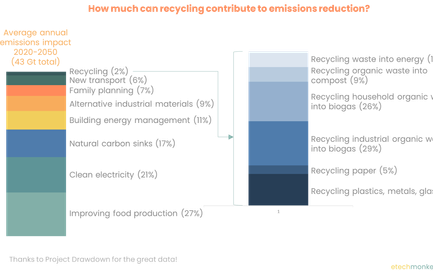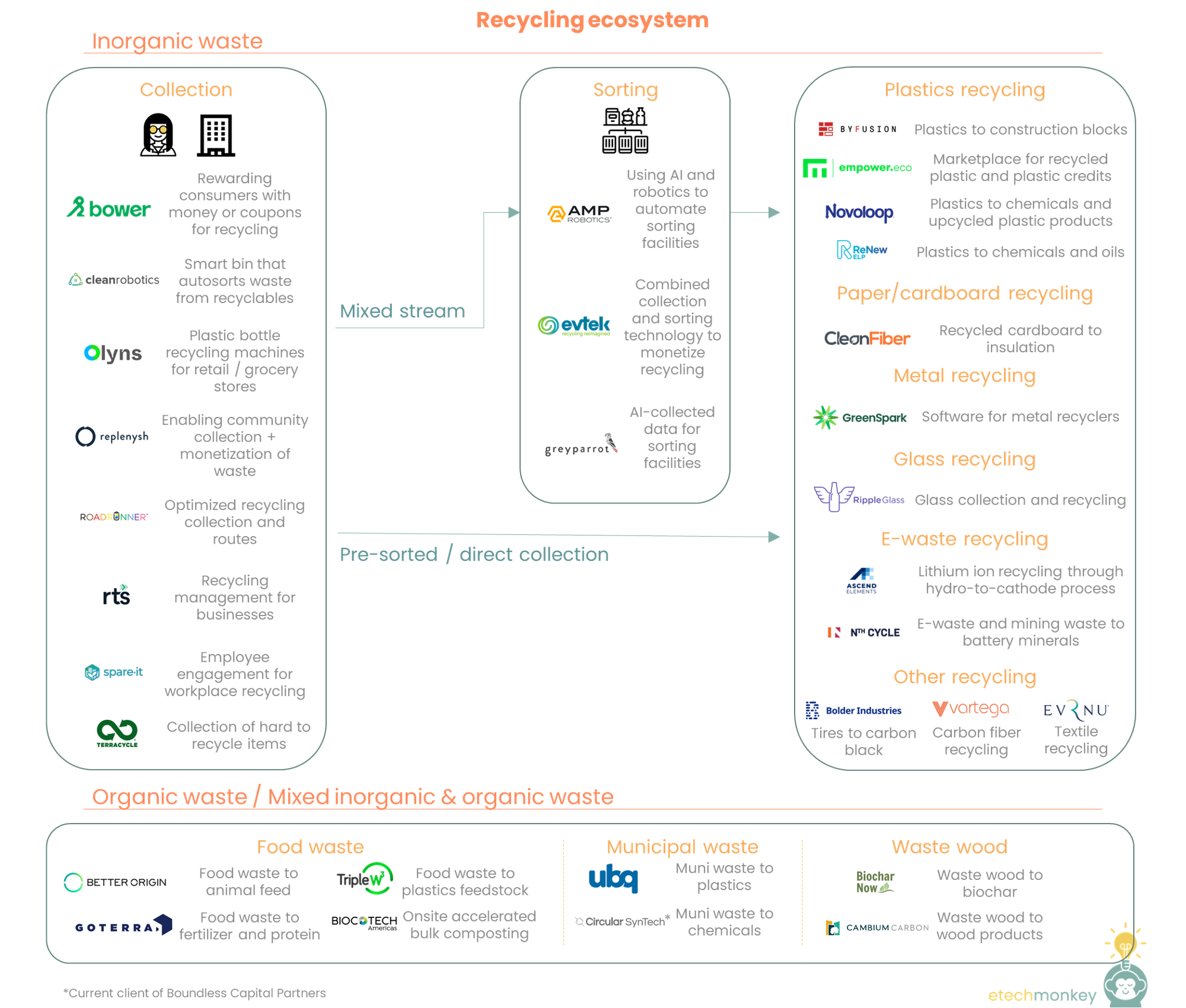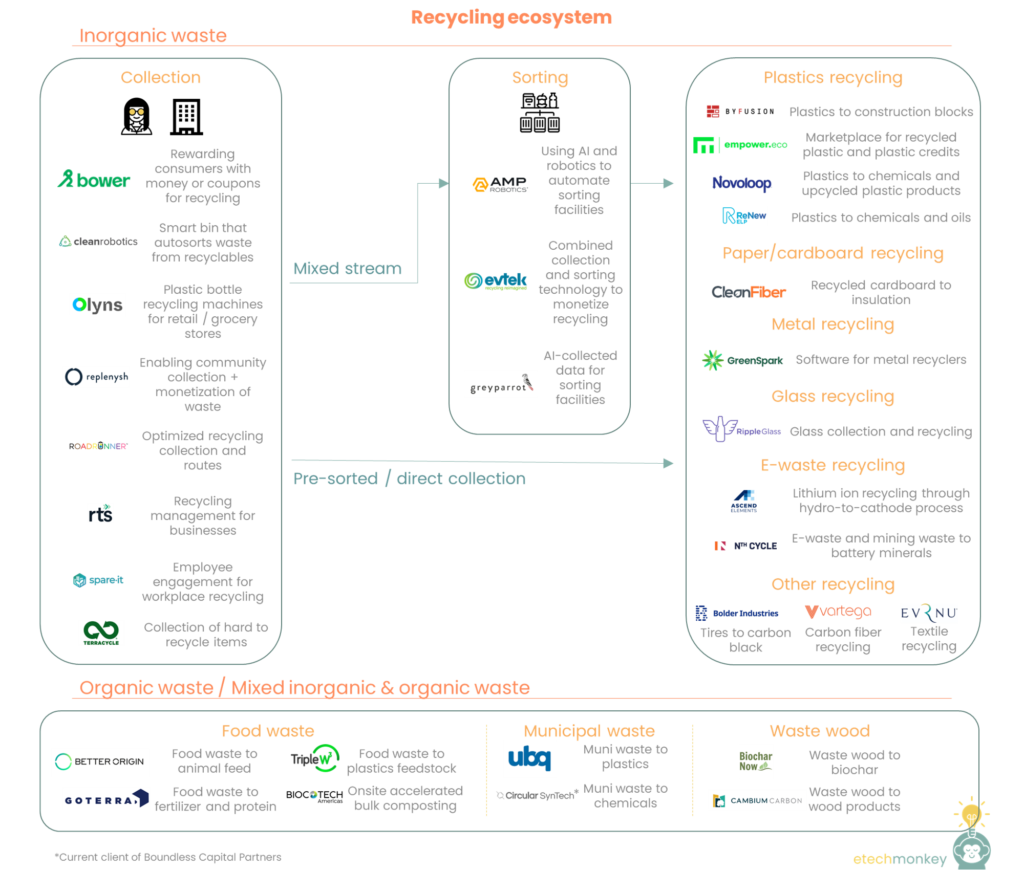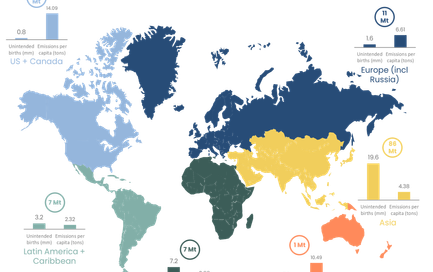
Recycling...an old problem with new ideas (circular economy Pt 2)

To continue with the circular economy theme, this week I’m covering different technologies that have emerged in recycling.
The landscape can be divided into two parts: inorganic waste and organic waste. Inorganic waste includes your typical recyclables (cardboard, plastic, glass) and other waste that is harder to break down in a landfill (textiles, carbon fiber). Organic waste is waste that contains organic compounds like food waste, biodegradable materials, wood, waste plants, etc.
When we think of recycling, we usually think of inorganic waste. Since it can’t be easily broken down by microbial organisms, inorganic waste must be 1) collected & transported to a sorting center, 2) sorted into different bales of material, and 3) shipped off to specialized processing facilities for recycling into new materials or products. Each one of these steps has a variety of startups attached to them:
(Note that the companies mentioned are not vetted or sorted. This is just a list I compiled of advertised technologies from various companies)
- Collection involves collection from both individuals and businesses.
- For individuals, companies have focused on removing the cost burden and inconvenience of recycling. Bower, for example, created an app to validate and pay individuals for recycling an item using a combination of barcode scanning and image verification. Similarly, Olyns puts collection machines in high-traffic locations like grocery stores and pays the consumer to recycle plastic bottles via the machine. Other companies, like Terracycle, simply provide free recycling programs to consumers for certain items not accepted by typical curbside recycling programs.
- For businesses, solutions are more varied. Clean Robotics makes a smart bin (“Trashbot”) to auto-sort trash – great for places like malls and airports. Spare it’s hybrid software/hardware solution helps businesses monitor office-wide recycling and hold recycling competitions for its employees. Replenysh offers a way for businesses (or other local entities) to become community collection points and get paid for recyclables collected at those points. Other companies like Roadrunner and Recycle Track Systems (RTS) sell businesses efficient bulk recycling solutions. Roadrunner does this through optimized recycling routes while RTS has a sophisticated monitoring + management software that businesses can use to track pickups and waste diversion metrics.
- For individuals, companies have focused on removing the cost burden and inconvenience of recycling. Bower, for example, created an app to validate and pay individuals for recycling an item using a combination of barcode scanning and image verification. Similarly, Olyns puts collection machines in high-traffic locations like grocery stores and pays the consumer to recycle plastic bottles via the machine. Other companies, like Terracycle, simply provide free recycling programs to consumers for certain items not accepted by typical curbside recycling programs.
- Sorting is the separation of different materials prior to those materials being sent to specialized recycling facilities. Traditional sorting centers hire people to manually sort recyclables off the belt. Because of how contaminated the recycling stream usually is, manual sorting is disgusting work and can be pretty dangerous.
- Several startups are working on automating sorting at these facilities. AMP Robotics has developed a proprietary computer vision and robotics system that can be used in both new and existing sorting facilities. Greyparrot uses its AI to provide sorters with real-time composition data and allow sorters to optimize their facilities. Evtek combines collection with sorting technology to provide collectors with fast analysis and monetization of their hauls.
- Several startups are working on automating sorting at these facilities. AMP Robotics has developed a proprietary computer vision and robotics system that can be used in both new and existing sorting facilities. Greyparrot uses its AI to provide sorters with real-time composition data and allow sorters to optimize their facilities. Evtek combines collection with sorting technology to provide collectors with fast analysis and monetization of their hauls.
- The vast majority of companies in this space work on new technologies to aid in specialized recycling, i.e. finding new ways to turn one material and recycling it into either the same material or a different material.
- Plastics recycling is probably the most discussed category in this section because of how difficult plastics are to recycle. Many different types of plastics exist and are hard to identify, even with the numbering system. That makes separating plastics into the right streams for recycling an error-prone process and increases the probability that plastics get downcycled into lower quality materials. Add to that the ever-growing volume of plastics, their low degradation rates, and their high rates of single-use, and the issue of plastics pollution seems to grow exponentially every year. Startups in this area are working on all sides of the plastics recycling problem: some like Empower are creating recycled plastics and plastics credits marketplaces to help drive more buyers and more value to recycled plastics. Companies like Novoloop and ReNew ELP are using novel processes to efficiently break plastics down into high value monomers or chemicals and fuel feedstocks. Others like ByFusion use plastics as replacements for carbon intensive materials like those used in construction (a form of downcycling that has a robust, valuable market).
- Cardboard and paper recycling is much more straightforward than plastics recycling. Cardboard and paper both are widely recycled today, composing 2/3 of municipal waste that’s recycled in the US. There aren’t many companies that are working on improving cardboard and paper recycling because of how efficiently the process already is. But one area here that’s seen some startup activity is using recycled cardboard to replace carbon intensive materials. CleanFiber, for example, is using recycled cardboard for building insulation.
- Metal recycling is another area that already experiences higher recycling rates. I don’t see many startups in this area working on new processes for metal recycling (with the exception of specialty “metals” like those used for e-waste or powder coatings) but rather improving the efficiency of the process. GreenSpark is one company that has developed software for metal recyclers to optimize their recycling processes.
- Glass recycling is an interesting area because it should have high rates of recycling with how easy glass is to recycle but falls short due to the logistics of moving glass around. Glass is very heavy and hazardous to move around, and combined with how cheap virgin glass is to make, the value proposition is often not there for large volume glass recycling at remote locations. The flip side of this is that recycling glass locally does make sense, so some startups, like RippleGlass, have developed more distributed models of glass recycling to help offset hauling costs.
- E-waste is a huge area for recycling because of the complexity and toxicity of the materials involved. Batteries have come to be a focal point for this part of the energy transition. Companies like Ascend Elements use a novel process to recycle lithium ion batteries. Others like Nth Cycle handle general e-waste and mining waste to recycle into critical battery minerals.
- Other types of specialty recycling do exist as well. For example, Bolder Industries recycles tires into carbon black, Vartega recycles carbon fiber, and Evrnu recycles cotton fiber to new textiles. I could write another article on just this “other” category alone…
- Plastics recycling is probably the most discussed category in this section because of how difficult plastics are to recycle. Many different types of plastics exist and are hard to identify, even with the numbering system. That makes separating plastics into the right streams for recycling an error-prone process and increases the probability that plastics get downcycled into lower quality materials. Add to that the ever-growing volume of plastics, their low degradation rates, and their high rates of single-use, and the issue of plastics pollution seems to grow exponentially every year. Startups in this area are working on all sides of the plastics recycling problem: some like Empower are creating recycled plastics and plastics credits marketplaces to help drive more buyers and more value to recycled plastics. Companies like Novoloop and ReNew ELP are using novel processes to efficiently break plastics down into high value monomers or chemicals and fuel feedstocks. Others like ByFusion use plastics as replacements for carbon intensive materials like those used in construction (a form of downcycling that has a robust, valuable market).
Recycling organic waste is also a very important part of the recycling ecosystem. Organic waste can generally be divided into food/ag waste, municipal waste, and waste wood (wastewater sometimes get included in this too, but I think water warrants its own topic).
- Food waste is an incredibly impactful category on emissions. Some experts, like those at Project Drawdown, even consider food waste as the #1 potential emissions reduction category from now until 2050 (under Scenario 1). Part of this is attributed to non-recycling food waste solutions, i.e. higher efficiency food production and better food consumption practices (e.g. embracing imperfect produce). But the remainder is certainly what I would call recycling: transforming food waste into other materials. The glaringly obvious food waste-to-compost pathways is already widely practiced at both the individual and entity levels but some companies like BioCoTech are developing speedier and more efficient composters. Other companies create new uses for food waste. Examples include Better Origin, which transforms food waste to animal feed, GoTerra, which transforms food waste into fertilizer and protein, and TripleW, which transforms food waste into plastics feedstocks.
- Municipal waste management is another broader category that overlaps with recycling. Startups in this area are working on new processes to turn unsorted municipal waste, which often contains a significant amount of organic waste in addition to inorganic waste, into other products. UBQ, for example, has figured out a way to transform municipal waste into plastics while Circular SynTech* can turn municipal waste into chemicals.
- The final big category of organic waste that I’ll cover today is waste wood. Wood is primarily wasted in construction/demolition, packaging, furniture disposal, and processing. This wood can be used for biomass energy or recycled into other materials. For example, BiocharNow can create biochar from waste wood using a pyrolysis process. Other companies like Cambium Carbon simply recycle the waste wood into wood products.
All of this just covers a fraction of the innovation we need in recycling. Making anything valuable from discarded material is a hugely creative task and will require the scrappiest of entrepreneurs, pun intended.

*Circular SynTech is a client of Boundless Capital Partners, of which I am an advisor.

